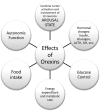Orexin-A controls sympathetic activity and eating behavior
- PMID: 25250003
- PMCID: PMC4157463
- DOI: 10.3389/fpsyg.2014.00997
Orexin-A controls sympathetic activity and eating behavior
Abstract
It is extremely important for the health to understand the regulatory mechanisms of energy expenditure. These regulatory mechanisms play a central role in the pathogenesis of body weight alteration. The hypothalamus integrates nutritional information derived from all peripheral organs. This region of the brain controls hormonal secretions and neural pathways of the brainstem. Orexin-A is a hypothalamic neuropeptide involved in the regulation of feeding behavior, sleep-wakefulness rhythm, and neuroendocrine homeostasis. This neuropeptide is involved in the control of the sympathetic activation, blood pressure, metabolic status, and blood glucose level. This minireview focuses on relationship between the sympathetic nervous system and orexin-A in the control of eating behavior and energy expenditure. The "thermoregulatory hypothesis" of food intake is analyzed, underlining the role played by orexin-A in the control of food intake related to body temperature. Furthermore, the paradoxical eating behavior induced orexin-A is illustrated in this minireview.
Keywords: behavior; body weight; energy expenditure; orexin-A; sympathetic nervous system.
Figures
References
-
- Bray G. A. (1991). Obesity, a disorder of nutrient partitioning: the MONA LISA hypothesis. J. Nutr. 121 1146–1162 - PubMed
Publication types
LinkOut - more resources
Full Text Sources
Other Literature Sources



